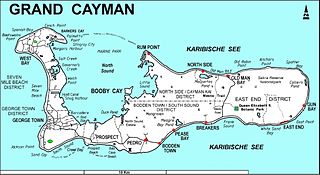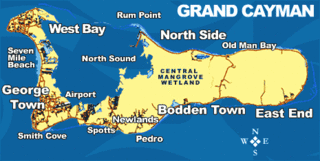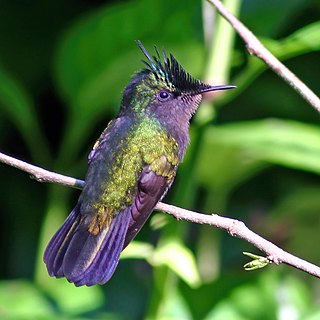

The Merrywing Pond System is a golf course wetland system in Anguilla, a British Overseas Territory in the Caribbean Sea. It forms one of the territory's Important Bird Areas (IBAs).


The Merrywing Pond System is a golf course wetland system in Anguilla, a British Overseas Territory in the Caribbean Sea. It forms one of the territory's Important Bird Areas (IBAs).
The IBA comprises five small ponds and their associated vegetation, with a total area of about 9 ha, on the Cuisinart Golf Course, near the south-western end of the main island, next to Rendezvous and Merrywing Bays. Two of the ponds are artificial, and are used as freshwater reservoirs for irrigation; the other three are natural and brackish, receiving both freshwater runoff from rainfall and seawater seepage from the bays. The site is vegetated with a mix of native and exotic ornamental plants. [1]
The IBA was identified as such by BirdLife International because it supports populations of green-throated caribs, Caribbean elaenias and Lesser Antillean bullfinches. [1]

Redberry Lake is a lake near Hafford in the Canadian province of Saskatchewan. It is a medium-sized saline lake within an area characterized by mostly freshwater aquatic environments. The lake makes up the core protected area of the Redberry Lake (UNESCO) Biosphere Reserve, and is a federal bird sanctuary of the same name. It is an Important Bird Area (IBA) of Canada designated as Redberry Lake . A small regional park is situated at the north-west corner of the lake. The countryside surrounding Redberry Lake is typical of the aspen parkland biome of which it is a part.

Cove Pond is a shallow 287 ha wetland at the south-western end of the Caribbean island of Anguilla, a British Overseas Territory. It forms part of a larger coastal lagoon from which it is separated by a causeway constructed for access to the Cap Juluca resort.

Grey Pond is a 191 ha shallow, brackish lagoon at the eastern end of the main island of Anguilla, a British Overseas Territory in the Caribbean. Its southern and eastern shores are relatively steep-sided limestone slopes, while its north-eastern corner is separated from Savannah Bay by a belt of sand dunes. The limestone shores are covered by low, scrub vegetation.

Long Pond, also known as Long Salt Pond, is a 23 ha brackish lagoon on the central south-eastern coast of the main island of Anguilla, a British Overseas Territory in the Caribbean. About 1.2 km long, it is separated from the sea at its eastern end by sand dunes. Its south shore is separated from the sea by a 300 m wide strip of scrub vegetation on limestone. The area to the north and west is residential.

Booby Pond Nature Reserve is a protected wetland on Little Cayman, one of the Cayman Islands, a British Overseas Territory in the Caribbean Sea.

The Botanic Park and Salina Reserve Important Bird Area comprises two separate sites on Grand Cayman, one of the Cayman Islands, a British Overseas Territory in the Caribbean Sea.

The Central Manrove Wetland is a large area of mangrove dominated wetland on Grand Cayman, one of the Cayman Islands, a British Overseas Territory in the Caribbean Sea. It is one of the territory's Important Bird Areas (IBAs).

The Crown Wetlands lie on Little Cayman, one of the Cayman Islands, a British Overseas Territory in the Caribbean Sea. Collectively they form one of the territory's Important Bird Areas (IBAs).

Mastic Reserve lies at the eastern end of the North Side of Grand Cayman, one of the Cayman Islands, a British Overseas Territory in the Caribbean Sea. It, with the associated Mastic Trail, is managed by the National Trust for the Cayman Islands and is one of the territory's Important Bird Areas (IBAs). It is named after the yellow mastic and black mastic trees which occur in the reserve.

Road Salt Pond, also known as Road Bay Pond or simply Road Pond, is a wetland in Anguilla, a British Overseas Territory in the Caribbean Sea. It is one of the territory's Important Bird Areas (IBAs).

Cauls Pond is a wetland in Anguilla, a British Overseas Territory in the Caribbean Sea. It is one of the territory's Important Bird Areas (IBAs).

West End Pond is a wetland in Anguilla, a British Overseas Territory in the Caribbean Sea. It is one of the territory's Important Bird Areas (IBAs).

Rendezvous Bay Pond, also known as Rendezvous Bay Salt Pond, is a wetland in Anguilla, a British Overseas Territory in the Caribbean Sea. It is one of the territory's Important Bird Areas (IBAs).

Meads Bay Pond is a wetland in Anguilla, a British Overseas Territory in the Caribbean Sea. It is one of the territory's Important Bird Areas (IBAs).

Forest Bay Pond is a small wetland in Anguilla, a British Overseas Territory in the Caribbean Sea. It forms one of the territory's Important Bird Areas (IBAs).

The Fish Ponds and Crossing Place Trail Important Bird Area is a 1024 ha tract of land on the island of Middle Caicos in the Turks and Caicos Islands, a British Overseas Territory in the Lucayan Archipelago of the western Atlantic Ocean. It forms one of the territory's Important Bird Areas (IBAs).

Fresh Pond is a 14 ha water body in the country of Sint Maarten on the island of Saint Martin in the Dutch Caribbean. It has been identified as an Important Bird Area by BirdLife International because it supports populations of various threatened or restricted-range bird species. Some 2.5 km long by 1 km across, it lies within the capital city of Philipsburg. Because of its low salinity, it supports species which are less common in other parts of the island. The pond is bordered with reeds, mangroves and coconut palms. American coots have been recorded breeding at the site, as well as snowy egrets, pied-billed grebes, common moorhens, great egrets, white-cheeked pintails and ruddy ducks. Other birds for which the IBA was designated include green-throated caribs, Antillean crested hummingbirds, Caribbean elaenias, pearly-eyed thrashers and lesser Antillean bullfinches.

Little Bay is an 8 ha coastal pond in the country of Sint Maarten on the island of Saint Martin in the Dutch Caribbean. It has a low salinity and lies near the capital, Philipsburg. It has been identified as an Important Bird Area by BirdLife International because it supports threatened or restricted-range bird species. Birds for which the IBA was designated include green-throated caribs, Antillean crested hummingbirds, Caribbean elaenias, pearly-eyed thrashers and lesser Antillean bullfinches. Pied-billed grebes, common moorhens, American coots, white-cheeked pintails and ruddy ducks have been recorded nesting at the site.

The Ryder Bay Islands Important Bird Area is a 520 ha designated site on the south-east coast of Adelaide Island, Antarctica. It has been identified as an Important Bird Area (IBA) by BirdLife International because it supports significant numbers of breeding seabirds, notably south polar skuas. The site encompasses the Léonie Islands lying at the mouth of Ryder Bay, as well as Rothera Point, the eastern headland of the bay.
18°10′36″N63°07′36″W / 18.17667°N 63.12667°W